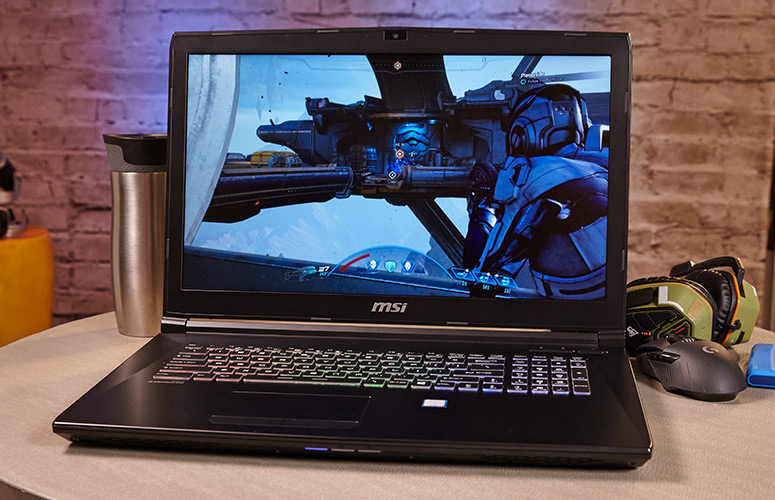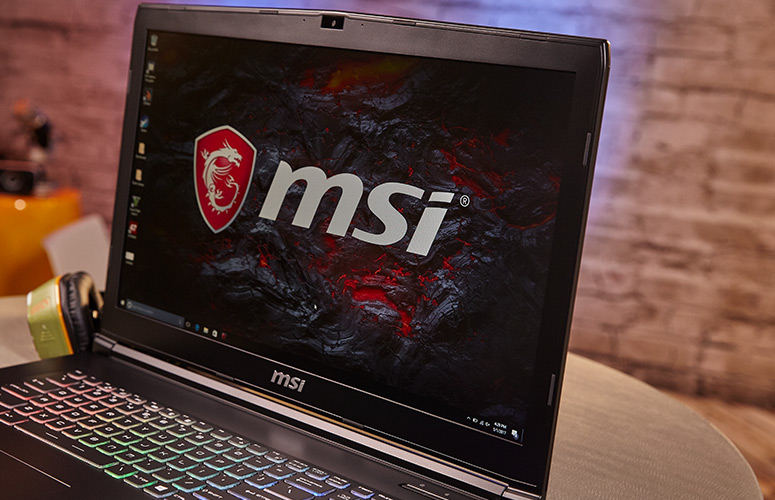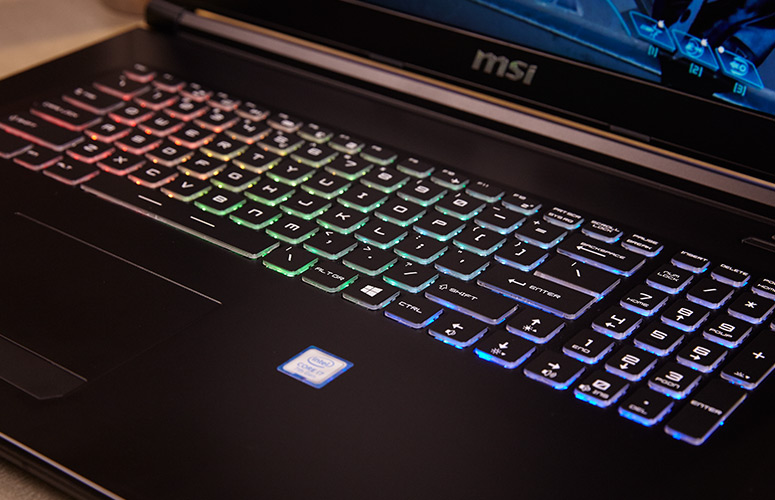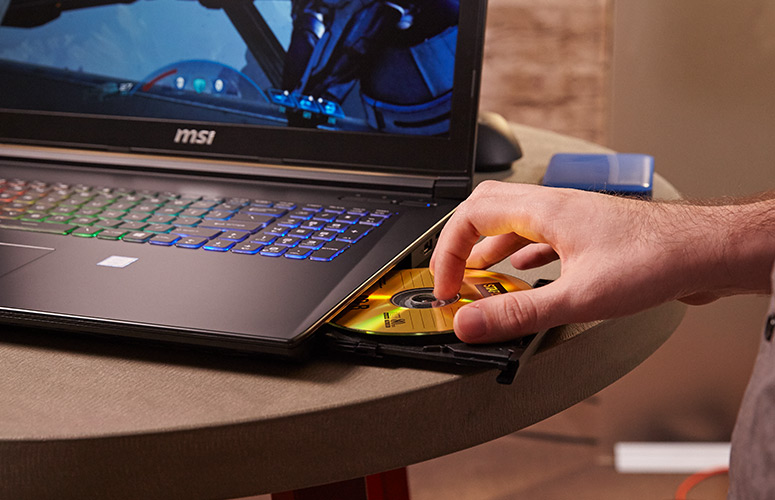Laptop Mag Verdict
The MSI GP72VR 7RFX Leopard Pro offers a vivid display, strong gaming performance and a comfortable keyboard, but its battery life is far shorter than the competition.
Pros
- +
Vivid display
- +
Solid performance
- +
Comfortable keyboard
Cons
- -
Very short battery life
- -
More expensive than competitors
Why you can trust Laptop Mag
MSI is known for its hard-core gaming cred, but its new GPX series is meant to deliver strong performance at relatively reasonable prices. The GP72VR 7RFX ($1,599 as reviewed; $1,199 to start) packs an Nvidia GeForce GTX 1060 GPU and Intel Core i7 CPU for VR readiness at less than $2,000. The laptop's vivid display and comfortable keyboard make it easy to recommend, though you'll need to carry a charger with you. Also realize that you're paying a bit extra for the MSI's stylish design and RGB-backlit keyboard.
Design
The Leopard Pro doesn't do anything to move MSI's design forward. It's not bad, just the same. That means you get a black aluminum chassis (though the very bottom is plastic) and a lid with the MSI logo and red dragon shield. There are slight curves on the lid that give it an air of power, but no so much that it's intimidating.
When I lifted the lid, I was greeted by a 17.3-inch display with a thick bezel and an RGB backlit keyboard complete with number pad (more on that below).
At 6.4 pounds and 16.5 x 10.6 x 1.5 inches, the Leopard isn't the smallest 17-inch gaming laptop, but it is one of the lightest, matched in weight by the slightly smaller Asus ROG Strix GL753VE (16.3 x 10.7 x 1.3 inches). The Acer Aspire V17 Nitro Black Edition is a little bigger at 7 pounds and 16.3 x 11.7 x 1.1 inches. The Alienware 17, however, was the largest at a mammoth 9.6 pounds and 16.7 x 13.1 x 1.2 inches.
The Leopard Pro has all of the ports you've come to expect for your various peripherals. On the left side, you get a Kensington lock slot, a pair of USB 3.0 ports, HDMI, a Mini DisplayPort, a USB Type-C, and headphone and microphone jacks. On the right side reside a DVD drive, a USB 2.0 port and an SD card reader.
Display
Sign up to receive The Snapshot, a free special dispatch from Laptop Mag, in your inbox.
I was wowed by the colors on the Leopard Pro's 17.3-inch, 1080p display. When I watched the trailer for "Thor: Ragnarok," Loki's cape was the perfect shade of emerald green, and an explosion rippling through Asgard was a stunning fiery red-orange. While I played Batman: Arkham Knight, I could see individual raindrops fall from the sky and purple and pink neon lights popped against the gray buildings in the city.
The screen reproduces an amazing 165 percent of the sRGB color gamut, surpassing the desktop-replacement average of 122 percent, the Strix (124 percent), the Aspire (118 percent) and the Alienware (113 percent).
Those hues are also more accurate on the Leopard Pro than most gaming laptops. MSI's display has a Delta-E score of 0.3 (0 is ideal), far lower than the average (1.41), and better than the Strix (2.2), the Aspire (3.3) and the Alienware (4).
The trade-off is that the Leopard Pro's panel, at 245 nits, isn't as bright as the others. The average is 290 nits, with the Strix measuring 285 nits, the Alienware, 278 nits, and the Aspire, 264 nits. Despite the numbers, I had no issues using the display, and didn't even feel the need to keep it at maximum brightness.
Keyboard and Touchpad
It's a pleasure to type on the Leopard Pro's SteelSeries keyboard. The comfortable switches measured 1.6 millimeters of travel with 70 grams of actuation force. The result is snappy, comfortable, responsive typing. On the 10fastfingers.com typing test, I reached 108 words-per-minute (just over my usual 107 wpm), with my usual 2 percent error rate.
The keyboard is RGB backlit, and it looks beautiful. While I'm a fan of the rainbow pattern that you get straight out of the box, the LED Wizard in the MSI Dragon Center lets you pick any color you like and add effects. Those effects include a special gaming mode that only lights up keys used for gaming, and a wave that lights up the keys from the left to the right.
The 4.2 x 2.4-inch keyboard is smooth and accurate. I had no issue browsing the web or navigating the desktop. Where I did run into problems, however, is gestures. While the Synaptics drivers allow for two-finger scrolling and pinch-to-zoom, it can't use more complex Window gestures like tapping three or four fingers to open the Action Center or Cortana.
Audio
The speakers on the back of the Leopard Pro are powerful and detailed, just the way I like it. I took the laptop into a small meeting room and listened to Lorde's "Green Light." The space was immediately filled with the sound of the vocals, keyboard, synth and backing beats. I used the Nahimic 2 audio software to tweak the settings. While fiddling with the bass and treble didn't do much, I squeezed out a bit more volume in the vocals with the "Vocal Clarity" slider.
When I played Batman: Arkham Knight, the character's voices sounded a bit hollow (Batman seemed just as far away as Robin when they were on a radio call), but there were great details, like individual raindrops pounding the pavement.
Gaming, Graphics and VR
The Leopard Pro's Nvidia GeForce GTX 1060 GPU with 3GB of VRAM is more than powerful enough to handle any video game or VR experience you throw at it, often at high settings. When I played Batman: Arkham Knight at 1080p, I turned all the settings up to high, and then, to further challenge the GPU, boosted the texture filtering up to 16x Anisotropic. The game still looked great, running between 57 and 70 frames per second while I glided over Gotham, maintaining a steady 58 fps in the middle of a battle between a tank and the Batmobile. The frame rate ratcheted up to 80 fps as I slowly navigated a warehouse while chasing down the Arkham Knight.
In our Rise of the Tomb Raider benchmark, the Leopard Pro played the game at 1080p on high settings at 33 fps, falling below the desktop-replacement average, which includes computers with more powerful GPUs like the Alienware, whose GTX 1070 GPU notched 50 fps.The Aspire (GTX 1060 GPU) managed 37 fps, but the Leopard outperformed the Strix (22 fps, GTX 1050 Ti), which fell below our 30-fps playability threshold.
On Grand Theft Auto V at 1080p and very high settings, the Leopard Pro rendered at 48 fps, again below the average (71 fps), the Aspire (62 fps) and the Alienware (60 fps) but better than the Strix (unplayable at 28 fps).
The GTX 1060 is a VR-ready GPU, and it showed off its prowess by earning a score of 7.1 on the StreamVR performance test. The average is 9.3, and the Alienware earned a 10.9. The Aspire, with the same GPU, reached 7.2, but the Strix, with its 1050 Ti, isn't ready for virtual reality.
Performance
Our Leopard Pro came armed with a 2.8-GHz Intel Core i7-7700HQ CPU, 16GB of RAM and a 512GB NVMe SSD. It didn't break a sweat when I had 45 tabs open, including one streaming a 1080p episode of "Last Week Tonight with John Oliver."
It notched a score of 12,147 on the Geekbench 4 overall-performance benchmark, falling under the desktop-replacement average (13,279) as well as the Strix (12,394, Core i7-7700HQ), the Aspire (13,333, Core i7-7700HQ) and the Alienware (14,020, Core i7-7820HK).
The Leopard took just 9 seconds to copy 4.97GB of mixed-media files, which translates to a rate of 565.5MBps. That's a hair faster than the average (562.5MBps) and blasts past the Strix (221.3MBps), the Aspire (231.3MBps) and the midtier Alienware (a sluggish 89.4MBps).
The Leopard Pro completed our OpenOffice spreadsheet macro test in 3 minutes and 24 seconds, pairing 20,000 names and addresses at the exact same time as the category average. The Alienware was slightly faster at 3:21, and the Aspire and Strix both completed the test in 3:19.
Battery Life
While we rarely see long-lasting gaming laptops, the Leopard Pro is still far shorter than the rest of the field.
MORE: Laptops with the Longest Battery Life
It lasted 2 hours and 32 minutes on the Laptop Mag Battery Test, falling short of the 4:18 desktop replacement average as well as the longer-lasting Strix (5:25), Aspire (5:30) and Alienware (8:32).
Heat
The Leopard Pro stayed cool in our testing, keeping below our comfort threshold of 95 degrees Fahrenheit after streaming 15 minutes of HD video from YouTube. The touchpad measured 94 degrees, the center of the keyboard measured 93 degrees and the bottom reached 88 degrees.
When I played Batman: Arkham Knight, the keyboard heated up to 115 degrees, the touchpad climbed to 108 degrees and the bottom hit 102 degrees.
Webcam
The 720p webcam on the Leopard Pro is fine for Skyping with friends, but you might want to get an external option for streaming to Twitch or YouTube. It's sharp; in a photo I took in our labs, I could make out the words written on a whiteboard behind me. The colors were off, though, and my blue eyes looked green and my royal blue shirt appeared navy.
Software and Warranty
MSI put a bunch of useful gaming software onto the Leopard Pro and folded almost all of it into one master program: MSI Dragon Center. It's essentially a hub that lets you launch other apps, control the keyboard lighting, monitor system performance and tune the fan speeds to your liking. It does so much that there's a hardware button on the keyboard to launch it. Other software includes the Nahimic 2 audio app, the SteelSeries Engine III to further customize the keyboard and an MSI-branded battery-calibration program.
You'll find the usual, unavoidable Windows bloatware in the start menu, including Candy Crush: Soda Saga, March of Empires, Sling, Facebook, Twitter and Minecraft: Windows 10 Edition.
MSI sells the GP72VR 7RFX Leopard Pro with a two-year warranty. See how MSI fared in our Tech Support Showdown and Best and Worst Brands rankings.
Configurations
The MSI GP72VR 7RFX Leopard Pro we reviewed cost $1,599 and included a 2.8-GHz Intel Core i7-7700HQ CPU, an Nvidia GeForce GTX 1060 GPU with 3GB of VRAM, 16GB of RAM and a 512GB NVMe SSD. There are two versions of the similarly named GP72X Leopard Pro with slightly different specs. One uses an Nvidia GeForce GTX 1050 Ti with 4GB of VRAM, a 256GB NVMe SSD and a 1TB, 7,200-rpm HDD, and costs $1,399. The other, a $1,199 model, uses a GTX 1050 with 4GB of VRAM, a 128GB NVMe SSD and a 1TB, 7,200-rpm HDD.
Bottom Line
If you're looking for one of the cheapest 17-inch VR-ready machines around, the Leopard Pro is a strong choice. At $1,599, its Intel Core i7-7700HQ CPU and Nvidia GeForce GTX 1060 GPU offer solid performance (though you'll lose the VR-readiness on cheaper models).
But the $1,399 Acer Aspire V17 Nitro Black Edition offers identical specs in its starting configuration and adds Tobii Eye-tracking. The V17's display is strong (though not as good as the Leopard Pro) and it has a comfortable keyboard. But you'll have to appreciate its more conservative design, live without an RGB backlit keyboard and uninstall an inordinate amount bloatware.
The Leopard Pro wins on its screen and more customizable design -- especially the RGB keyboard, but to buy it, you'll have to decide if those features are worth paying $200 more than a competitor with similar components.
Credit: Jeremy Lips/Laptop Mag
MSI GP72VR 7RFX Leopard Pro Specs
| Bluetooth | Bluetooth 4.2 |
| Brand | MSI |
| CPU | 2.8 GHz Intel Core i7-7700HQ CPU |
| Card Slots | SD/SDHC Card reader |
| Company Website | msi.com |
| Display Size | 17.3 |
| Graphics Card | Nvidia GTX 1060 3GB / Intel HD Graphics 630 |
| Hard Drive Size | 512GB |
| Hard Drive Type | SSD |
| Highest Available Resolution | 1920 x 1080 |
| Native Resolution | 1920x1080 |
| Operating System | Windows 10 Home |
| Optical Drive | Super-Multi DVD |
| Ports (excluding USB) | Kensington Lock, Microphone, USB Type-C, Mini DisplayPort, USB 3.0, SD card slot, USB 2.0, HDMI, Headphone |
| RAM | 16GB |
| Size | 16.45 x 10.60 x 1.53 inches |
| Touchpad Size | 4.2 x 2.4 inches |
| USB Ports | 4 |
| Video Memory | 3GB |
| Warranty/Support | 2 years |
| Weight | 6.4 pounds |
| Wi-Fi | 802.11ac |
| Wi-Fi Model | 802.11ac |
Andrew is a contributing writer at Laptop Mag. His main focus lies in helpful how-to guides and laptop reviews, including Asus, Microsoft Surface, Samsung Chromebook, and Dell. He has also dabbled in peripherals, including webcams and docking stations. His work has also appeared in Tom's Hardware, Tom's Guide, PCMag, Kotaku, and Complex. He fondly remembers his first computer: a Gateway that still lives in a spare room in his parents' home, albeit without an internet connection. When he’s not writing about tech, you can find him playing video games, checking social media and waiting for the next Marvel movie.






